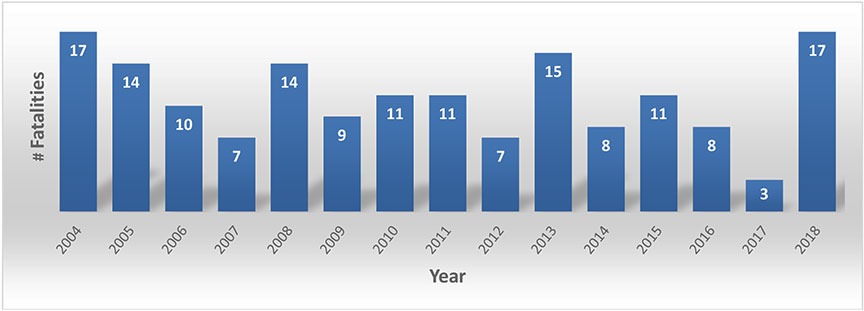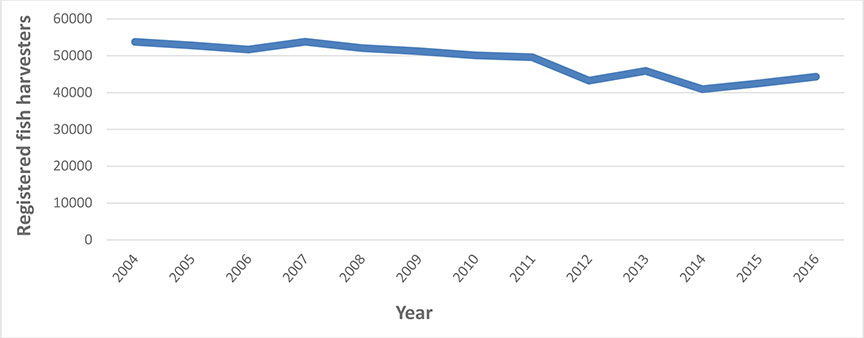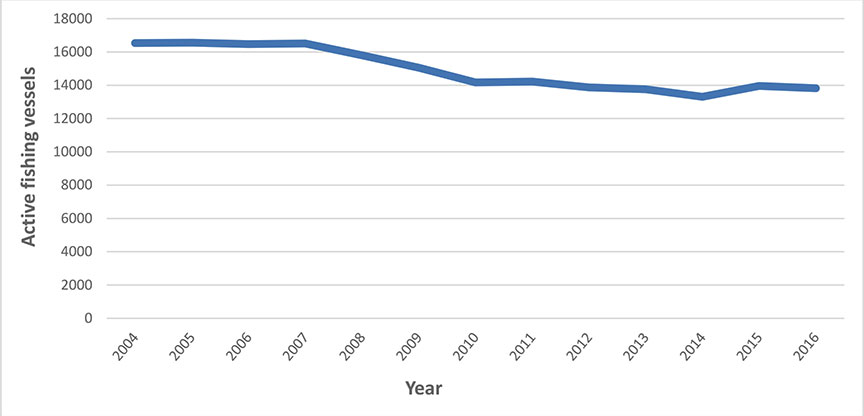Every year, safety deficiencies onboard fishing vessels continue to put at risk the lives of thousands of Canadian fish harvesters and the livelihoods of their families and communities. Various initiatives have sparked the development of a safety culture within the industry, but progress has been slow, sporadic, and localized.
The situation
The fishing industry—in Canada as abroad—has long registered disproportionately large numbers of accidents and fatalities.Footnote 1 Since 1992, the Transportation Safety Board of Canada (TSB) has made 48 recommendationsFootnote 2 to address safety deficiencies, 13 (27%) of which are still outstanding. Fishing safety has been on the Watchlist since 2010.
In 2012, the TSB released a safety issues investigationFootnote 3 on the root causes of fatal fishing vessel accidents. Findings highlighted a number of systemic factors requiring attention, in particular: vessel modifications and their impact on stability; the lack of or failure to use lifesaving equipment, such as personal flotation devices (PFDs), immersion suits and emergency signaling devices; unsafe work practices; and inadequate regulatory oversight.
Number of occurrences in Canada
From 2011 to 2017, the TSB conducted 24 investigations where these systemic factors were associated with findings as to risk.Footnote 4 As shown in Table 1 below, the same period witnessed 63 fishing fatalities—an average of 9 fatalities per year—resulting from 47 fishing vessel accidents. Nearly 43% of those fatalities were due to falling overboard, and 35% to stability-related issues. The use of PFDs could not be ascertained in about 80% of the fatalities. No emergency signal was received by authorities in nearly half of the fatalities (44%).
| 2011 | 2012 | 2013 | 2014 | 2015 | 2016 | 2017 | Total | Fatalities by accident type as a percentage of all fatalities | |
|---|---|---|---|---|---|---|---|---|---|
| Person(s) falling overboard | 9 | 2 | 3 | 6 | 5 | 0 | 2 | 27 | 43% |
| Stability-related | 0 | 1 | 6 | 2 | 6 | 6 | 1 | 22 | 35% |
| Accident on board | 0 | 4 | 3 | 0 | 0 | 2 | 0 | 9 | 14% |
| Grounding | 1 | 0 | 3 | 0 | 0 | 0 | 0 | 4 | 6% |
| Fire | 1 | 0 | 0 | 0 | 0 | 0 | 0 | 1 | 2% |
| Total | 11 | 7 | 15 | 8 | 11 | 8 | 3 | 63 | 100% |
| 2011 | 2012 | 2013 | 2014 | 2015 | 2016 | 2017 | Total | Percent | |
|---|---|---|---|---|---|---|---|---|---|
| Total fatalities (all accident types) | 11 | 7 | 15 | 8 | 11 | 8 | 3 | 63 | 100% |
| Fatalities in which PFD use was confirmed | 0 | 4 | 3 | 0 | 3 | 4 | 1 | 15 | *24% |
| Fatalities in which there was no emergency signal | 5 | 1 | 7 | 3 | 8 | 4 | 0 | 28 | *44% |
Note:
* In some of the fatalities, there may have been both PFD use and no emergency signal.
Figure 1 shows the number of fishing fatalities over the last 15 years against the wider backdrop of commercial fishing activity in Canada in the same period (figure 2 and figure 3). Despite various safety initiatives, the number of fatalities continues to fluctuate widely from year to year without showing any sign of a downward trend. From 3 fatalities in 2017, the number increased to 17 in the first 10 months of 2018.
* Number of fatalities at 19 October 2018. Source: TSB database.
** Data for 2017 and 2018 not yet available. Source: Department of Fisheries and Oceans Canada.
** Data for 2017 and 2018 not yet available. Source: Department of Fisheries and Oceans Canada.
The risks to fish harvesters, their operations, and their livelihoods
Safety deficiencies in the fishing industry put at risk the lives of fish harvesters, the efficiency and continuity of their operations, and the livelihoods of their families and communities. Those risks will remain until concerted and coordinated actions by federal and provincial authorities, industry leaders and safety advocates effectively influence and reinforce changes in behaviours and attitudes.
Developing and sustaining a strong safety culture is required to foster greater compliance with regulations, in particular with respect to vessel stability and the use of life-saving equipment. Addressing these two safety deficiencies would contribute to a significant reduction in the number of fishing-related fatalities given the number of deaths currently associated with falling overboard or stability/capsizing events.
Actions taken
In 2017, Transport Canada introduced the first phase of the new Fishing Vessel Safety Regulations (for vessels up to 24.4 metres in length). It has implemented a number of oversight and education activities, by developing and delivering policy documents, inspector training, and guidance on the application of regulations. Transport Canada has also provided the fishing industry across the country with information and opportunities to participate in consultation sessions. In addition, it has implemented a program to help owners and operators ensure their vessels meet applicable regulations
Leadership from industry and communities
Some fishing associations have taken increasing leadership in developing guidelines for vessel modifications and stability. Some workers compensation boards have imposed fines to encourage safe work practices, and various organizations have launched education initiatives. As a result, there are signs of behavioural change among fish harvesters, but it is not consistent across regions and fisheries. Unlike other provinces, New Brunswick and Prince Edward Island still do not have workplace legislation that is applicable to fishing vessels. Cultural change takes time, and it is slowly evolving one wharf and one fish harvester at a time.
Engaging parliamentarians
In 2018, TSB officials appeared twice before parliamentary committees to comment on recent investigation reports into fatal accidents involving small fishing vesselsFootnote 5 and to discuss improvements needed to make Canada's commercial fishing industry safer.
Actions required
This issue will remain on the Watchlist until there are sufficient indications that a sound safety culture has taken root throughout the industry and in fishing communities across the country, namely:
- Federal and provincial authorities coordinate regulatory oversight of commercial fisheries to eliminate any existing gaps.
- Transport Canada publishes and promotes user-friendly guidelines on vessel stability designed to reduce unsafe practices.
- Fish harvesters are familiar with and adopt the new stability guidelines and the 2017 Fishing Vessel Safety Regulations to the extent that their change in practice is reflected in TSB investigations and focus group consultations with the industry.
- Spurred by the leadership of industry and safety advocates, there is marked and widespread evidence—notably in TSB investigations— of behavioural changes among fish harvesters with respect to the use of flotation devices, immersion suits, emergency signaling devices, and safe work practices.


